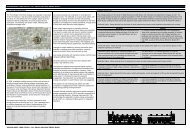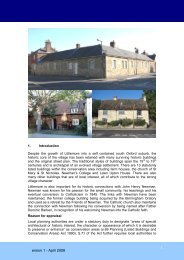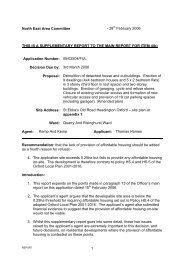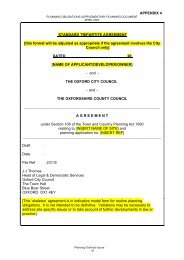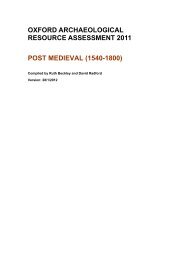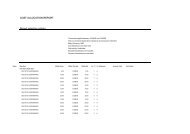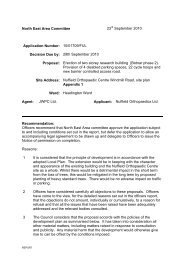Palaeolithic to Mesolithic Oxford (500000 - 4000 BC) - Oxford City ...
Palaeolithic to Mesolithic Oxford (500000 - 4000 BC) - Oxford City ...
Palaeolithic to Mesolithic Oxford (500000 - 4000 BC) - Oxford City ...
Create successful ePaper yourself
Turn your PDF publications into a flip-book with our unique Google optimized e-Paper software.
The <strong>Palaeolithic</strong> in <strong>Oxford</strong><br />
The dating framework<br />
The <strong>Palaeolithic</strong> in Britain spans a period from at least 700,000 years ago when the<br />
earliest documented evidence for human activity in the country is recorded until<br />
around 12,000 calibrated years BP at the end of the Pleis<strong>to</strong>cene epoch.<br />
The Pleis<strong>to</strong>cene is the most recent geological epoch and occurred from about 2.6<br />
million years ago until the end of the last glacial period about 12,000 calibrated years<br />
BP. It is known as a period of global climatic instability during which there were a<br />
succession of major warm and cold episodes involving glacial ice advances and<br />
retreats. Although geological deposits relating <strong>to</strong> some of these episodes are found<br />
on land, most knowledge of the complexity of climatic change during the period<br />
comes from the analysis of marine iso<strong>to</strong>pes in deep sea cores. Therefore, in referring<br />
<strong>to</strong> Pleis<strong>to</strong>cene deposits in Britain, including those associated with <strong>Palaeolithic</strong><br />
archaeological remains, it has become common <strong>to</strong> refer <strong>to</strong> global Marine Iso<strong>to</strong>pe<br />
Stage (MIS) as well as local names (Bridgeland 1994). Table 1 summarises the<br />
Pleis<strong>to</strong>cene deposits of the <strong>Oxford</strong> district.<br />
Period ka<br />
(thousand years<br />
ago)<br />
MIS Glacial stage <strong>Oxford</strong> Gravels Industry<br />
12 ka - present 1 Flandrian<br />
(Holocene)<br />
Floodplain <strong>Mesolithic</strong> <strong>to</strong> modern<br />
30-12 ka 2 Devensian<br />
Late Upper <strong>Palaeolithic</strong><br />
60-30 ka 3 (glacial) Northmoor Gravel Early Upper <strong>Palaeolithic</strong><br />
(floodplain gravels) Late Middle <strong>Palaeolithic</strong><br />
(British Mousterian)<br />
110-60 ka 4<br />
5a-c<br />
130-110 ka<br />
5d<br />
5e Ipswichian<br />
Interglacial<br />
Summer<strong>to</strong>wn-Radley<br />
Gravel Formation<br />
190-130 ka 6<br />
Eynsham Gravel (MIS 5e)<br />
245-190 ka<br />
7 Aveley<br />
Interglacial<br />
8<br />
340-300 ka 9<br />
10<br />
Purfleet<br />
interglacial<br />
425-380 ka 11 Hoxnian<br />
Interglacial<br />
12 Anglian<br />
(Glacial)<br />
c. 700-480 ka 13- ‘Cromerian<br />
17 Complex’<br />
Stan<strong>to</strong>n Harcourt Gravel<br />
(MIS 6)<br />
Stan<strong>to</strong>n Harcourt Channel<br />
Deposit (MIS 7)<br />
Wolvercote Gravel<br />
Wolvercote Channel<br />
Deposit (MIS 9)<br />
Hanborough Gravel<br />
Table 1: Pleis<strong>to</strong>cene chronology of the <strong>Oxford</strong> district<br />
Lower/Middle <strong>Palaeolithic</strong><br />
(Handaxe and Levallois<br />
industries)<br />
Lower <strong>Palaeolithic</strong>:<br />
handaxe and flake <strong>to</strong>ol<br />
industries)<br />
Northern Drift group Lower <strong>Palaeolithic</strong>:<br />
handaxe and flake <strong>to</strong>ol<br />
industries)<br />
OXFORD ARCHAEOLOGICAL RESOURCE ASSESSMENT- PALAEOLITHIC TO<br />
MESOLITHIC 5



